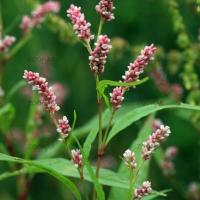Pale smartweed
Polygonum lapathifolium
Polygonum lapathifolium, commonly known as pale smartweed or nodding smartweed, is an annual or perennial herbaceous plant belonging to the Polygonaceae family. Native to North America and other parts of the world, it is often found in wetlands, along water bodies, and in disturbed areas.
Identification:
Appearance: Pale smartweed is characterized by its lance-shaped leaves, pink to pale pink flowers, and a distinctive nodding or drooping appearance of the flowering spikes. The plant can grow from 1 to 3 feet in height.
Distinctive Features:
- Growth Form: Annual or perennial herb with lance-shaped leaves.
- Flowers: Pink to pale pink, arranged in spikes that nod or droop.
- Habit: Often found in wetlands and along water bodies.
Habitat and Distribution:
Pale smartweed is commonly found in wet or marshy areas, along the edges of ponds, streams, and other water bodies. It can also thrive in disturbed areas, ditches, and roadsides. The plant has a wide distribution and is found in various regions around the world.
Ecological Significance:
-
Habitat Stabilization: In riparian zones, smartweeds like Polygonum lapathifolium play a role in stabilizing the soil and preventing erosion.
-
Wildlife Habitat: The plant provides habitat and food for various insects and waterfowl.
Cultural Significance:
While not typically cultivated for specific purposes, pale smartweed may be observed in naturalized or wild plant communities.
Caution:
- Invasive Potential: In some regions, certain smartweed species can be invasive, spreading rapidly in wetland areas.








